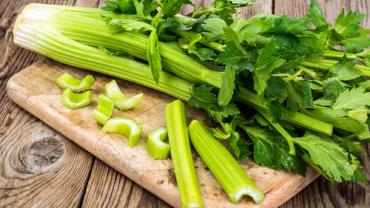
If there’s one food at the intersection of Paleo, vegetarian, vegan, low carb, ketogenic, kosher, halal, and low-calorie diets, it’s celery. For something that’s mostly water, celery has a lot going for it. It’s nutritious, delicious, inexpensive, and can be enjoyed raw or cooked. It may not be the kind of nutrient-packed “superfood” liver, shellfish, or spinach are, but it’s time for celery to move beyond its reputation as rabbit food and something only people on weight loss diets would ever eat.
Indeed, celery is good for weight loss. It’s around 95% water, extremely low in energy density and high in fiber, which means you can fill up on it without racking up the calories or generating an appreciable spike in blood glucose or insulin. It’s not loaded with nutrients the way more darkly colored vegetables are, but neither is it completely devoid of vitamins and minerals. Celery is a good source of vitamin K1, folate, potassium, calcium and manganese. With 100 grams containing zero fat, just 1 gram of protein, and 3 grams of carbohydrate—2 of which are fiber—celery really is mostly water. This being said, it’s not true that celery is a “negative calorie food” that contains fewer calories than are “burned” by digesting it.
Like any food, celery has its “haters,” but what would good cooking be without celery? No Cajun or Creole cook would be caught without a trinity on hand (celery, onions, and bell peppers), and the classic French mirepoix, made up of carrots, celery, and onions, has been the base for soups, stocks and stews almost as long as people have been setting pots over fires. And if celery’s versatility wasn’t enough, it’s no slouch when it comes to supporting good health. Celery extracts have shown hypoglycemic, antioxidant, hypolipidemic, and anti-platelet aggregation effects.
The beneficial effects of celery for lowering blood pressure are likely due to the vegetable’s high nitrate content. Along with other high-nitrate vegetables, such as beets and spinach, celery may help stimulate the production of nitric oxide, with the downstream result being enhanced vasodilation. Celery’s naturally high nitrate content is why celery juice and celery powder are used to preserve bacon and other cured meats when manufacturers prefer to advertise that their products contain no added nitrates.
Interestingly, very high consumption of or exposure to celery by sensitive individuals may result in phytophotodermatitis. Severe cases have been reported, as have cases among grocery store workers who had greater than usual contact with celery. These reactions are due to celery’s high content of psoralen, a type of furanocoumarin that is also present in parsnips. (Consumption of parsnips has led to reports of phytophotodermatitis as well, as they are botanically related to celery.)
Sweet and savory ways to enjoy celery abound. For kids, there’s the perennial favorite, “ants on a log,” which is celery filled with peanut butter and dotted with raisins (with many variations), and celery almost always makes an appearance on crudité platters at parties, where it’s excellent with hummus or ranch dressing. For more interesting ways to include celery in meals, don’t forget about Waldorf salad, chicken salad, or mustard & celery ground beef. And come winter holiday time, celery is great in gluten-free celery & herb stuffing, or sausage stuffing. Consider purchasing organic celery, as it appears on the Environmental Working Group’s “dirty dozen” list of commonly consumed foods that are high in pesticide residues.
And remember, there’s more to celery than just its crunchy stalks and flavorful leaves. For low carbers, celery root (also called celeriac) makes a great substitute for starchier vegetables. (It can be used to approximate mashed potatoes for those who are tired of using cauliflower.) It can also be used as the base for thick & creamy soups without dairy. And last but not least, tiny celery seeds are pretty impressive all on their own.